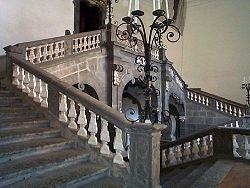
Palazzo Serra di Cassano
Encyclopedia

Naples
Naples is a city in Southern Italy, situated on the country's west coast by the Gulf of Naples. Lying between two notable volcanic regions, Mount Vesuvius and the Phlegraean Fields, it is the capital of the region of Campania and of the province of Naples...
, Italy
Italy
Italy , officially the Italian Republic languages]] under the European Charter for Regional or Minority Languages. In each of these, Italy's official name is as follows:;;;;;;;;), is a unitary parliamentary republic in South-Central Europe. To the north it borders France, Switzerland, Austria and...
, built for the wealthy Serra Family, one of the original 54 families of the 'old nobility' of Genoa, whose family was organized within an Albergo (family). The family insignia (crest) is frescoed on the ceiling of the Palazzo Serra's Great Hall. The family had economic interests in banking, insurance & law.
The Palazzo is behind the Piazza del Plebiscito
Piazza del Plebiscito
Piazza Plebiscito is one of the largest squares in Naples. It is named for the plebiscite taken on October 2 in 1860 that brought Naples into the unified Kingdom of Italy under the House of Savoy...
on via Monte di Dio, the road leading up to the height of the Pizzofalcone peak. It was built in 1730 by the architect, Ferdinando Sanfelice
Ferdinando Sanfelice
Ferdinando Sanfelice was an Italian late Baroque architect and painter.Sanfelice was born in Naples and died there. He was one of the principal architects in Naples in the first half of the 18th century. He was a student of Francesco Solimena.Sanfelice was known primarily for temporary displays...
, also responsible for the construction of the nearby Nunziatella
Nunziatella military academy
Besides to be a military training institution, the Nunziatella is a place of great cultural and civil heritage. Here the whole history of our country is summarized. I believe that the Republic of Italy has to treasure all its great military and civil traditions which originated in the country even...
, the Bourbon Military Academy founded in the days of the Kingdom of Naples
Kingdom of Naples
The Kingdom of Naples, comprising the southern part of the Italian peninsula, was the remainder of the old Kingdom of Sicily after secession of the island of Sicily as a result of the Sicilian Vespers rebellion of 1282. Known to contemporaries as the Kingdom of Sicily, it is dubbed Kingdom of...
, and still in operation.
Both the Duke of Cassano and the Palazzo Serra were known throughout Europe for their superb library. In the 19th Century that collection was sold to the Viscount Spencer. It is located today at Althorp, the country home and final resting place of Diana Spencer Windsor, Princess of Wales and at The Rylands Library, Manchester University, England.
The dual portals of the palace entrance, on the via Monte di Dio, open onto twin curved stairways leading up over an octagonal courtyard. The building originally had entrances on two different streets; the entrance that formerly opened onto via Egiziaca, facing the Royal Palace, was closed many years ago in 1799. The owner, Luigi Francesco Serra, The Duke of Cassano, closed it to protest the execution (beheading) of his son, Gennaro Serra. Gennaro, the Prince of Cassano, was said to be involved in the revolutionary activities of the Neapolitan Republic, and was handed over to Bourbon authorities by Admiral Horatio Nelson, who betrayed an agreement he had made with the revolutionaries.
Gennaro Serra's mother Giulia Carafa Serra, the Duchess of Cassano, was also suspected in the revolutionary plot and was banished from Naples for a period of seven years.
The building today houses the Istituto Italiano per gli Studi Filosofici (Italian Institute for Philosophical Studies).

